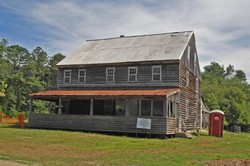The Ocean County Historical Society resumed its lecture series online with “A Great Place to Eat or Drink: Cedar Bridge,” hosted by Sean McHugh, adjunct professor and co-director of the Archaeological Field School of Monmouth University, on Sunday, March 7.
McHugh began the presentation with a background on archaeology before detailing the history and investigations of the tavern. Archaeology is a social science that falls under the larger umbrella of anthropology, which is the study of human societies and cultures, McHugh explained.
He emphasized that the most important word in the definition of archaeology is “material,” referring to the artifacts that can or have been altered in some way by humans. When asked by recent graduates on a direction to take, McHugh urged them to “go get lost in the field.”
“Literally, go work in the field for as many companies and as many parts of the country as you can,” McHugh said. “Learn your material then come back and get your master’s degree. While some of what is pictured can be obvious, knowing the difference between stoneware, earthenware, and ironstone ceramics matters.”
An archaeological site such as Cedar Ridge Tavern provides artifacts that tell a story of its past, McHugh explained. “Whether it is a cup, a bowl, or a mug, matters. This will indicate a small scale family use or mass consumption you would see at a restaurant or tavern.”
“Features” are artifacts that are not movable or if moved will destroy their defining characteristics. “Here’s the thing: archaeology is a destructive science,” McHugh said. “We single-handedly kill our informants. We have to get it right the first time. My nightmares are filled with the possibility of blowing through a feature while digging.”
Archaeology is labor intensive, so it utilizes sampling strategies to hone in potential archeological deposits, McHugh explained. “Shovel testing” helps cover a larger area. These tests are generally placed on a 50-foot interval grid focused on the presence of cultural material.
The Cedar Bridge Tavern is situated on a property that was purchased on December 4, 1712 by Thomas William Fox. Initially, the property was comprised of a 333-acre parcel in Shrewsbury, Monmouth County and the province of East Jersey.
The division line was later relocated east of the tavern property in 1743 with the original line remaining to demarcate the boundary between Burlington and Monmouth County. During their ownership, William died and a family member assumed control of his share of the property, which was continually sold and passed down for generations.
In the summer of 2010, the University metal detected and excavated 31 shovel tests and nine excavation units, resulting in the identification of 12 features, nine of which are classified as cultural, McHugh explained.
“In addition to the features, the students and staff of MU recovered 6409 artifacts,” McHugh said. “A small amount were prehistoric in origin.”
Despite the limited excavations, it was determined that the site was eligible for listing on the National Register of Historic Places under “Criterion D” for its ability to provide new information on 18th and 19th century farmsteads, consumerism, and food waste in the New Jersey Pineland region, McHugh explained. Archaeological excavations conducted by the University in 2004 included an additional 20 shovel tests, resulting in the recovery of 6797 more artifacts as well as the identification of 17 features.
“Testing within the building revealed subfloor predating the 19th century as well as a dog burial from the early 19th century, as well as a builder’s trench contemporary with the construction of the east wing of the tavern in the 1830s,” McHugh said. “In 2019, Monmouth University attempted to identify any Native American occupation within the property.”
While those excavations were not able to identify dense Native American deposit, additional features found at the tavern’s surrounding buildings and the recovery of numerous artifacts indicated that additional archaeological resources are present and could provide additional information to understand the ways of life at the site during the late 18th and 19th century before and during the use of Cedar Bridge Tavern.
IMAGE TAKEN from Wikipedia




